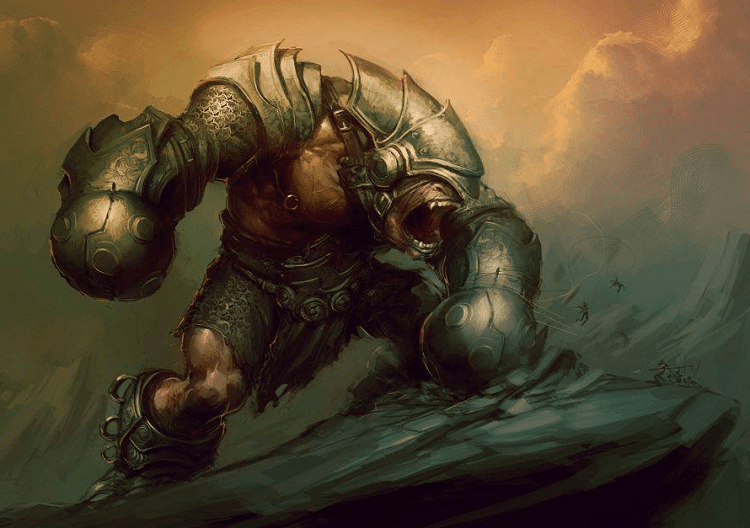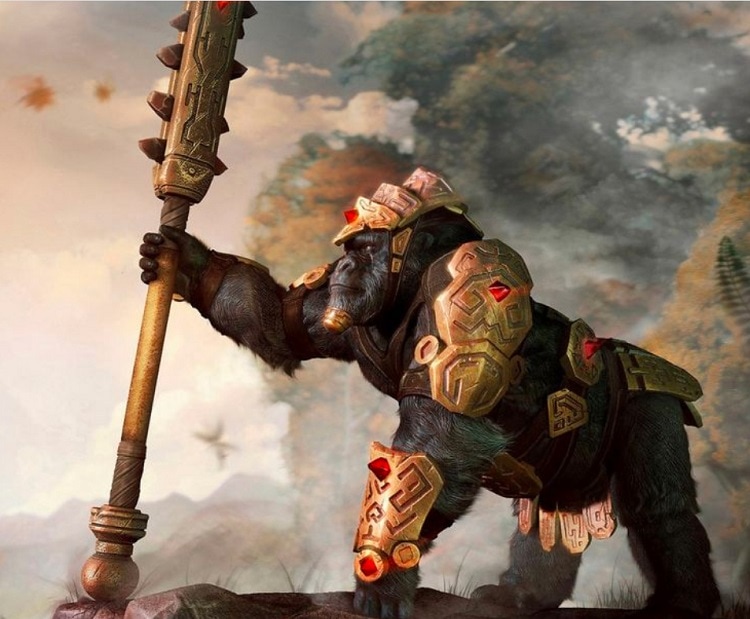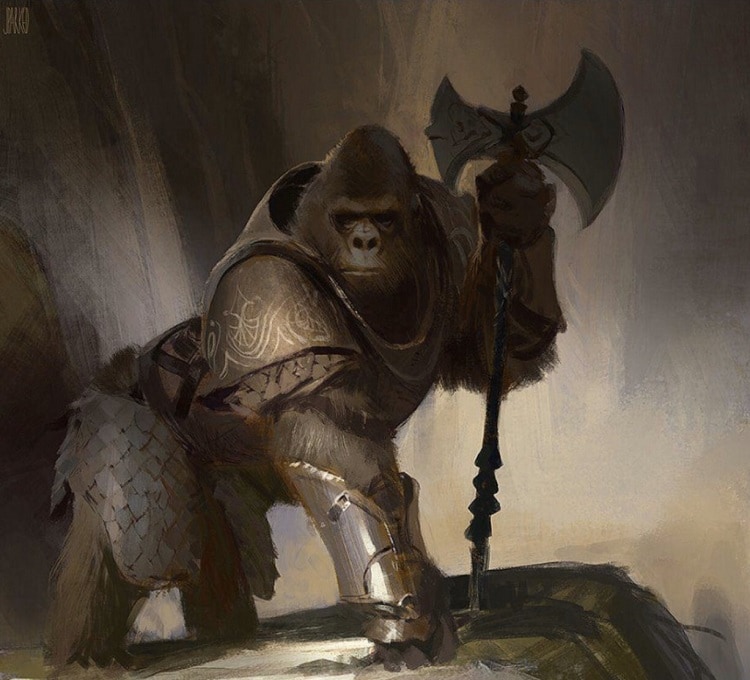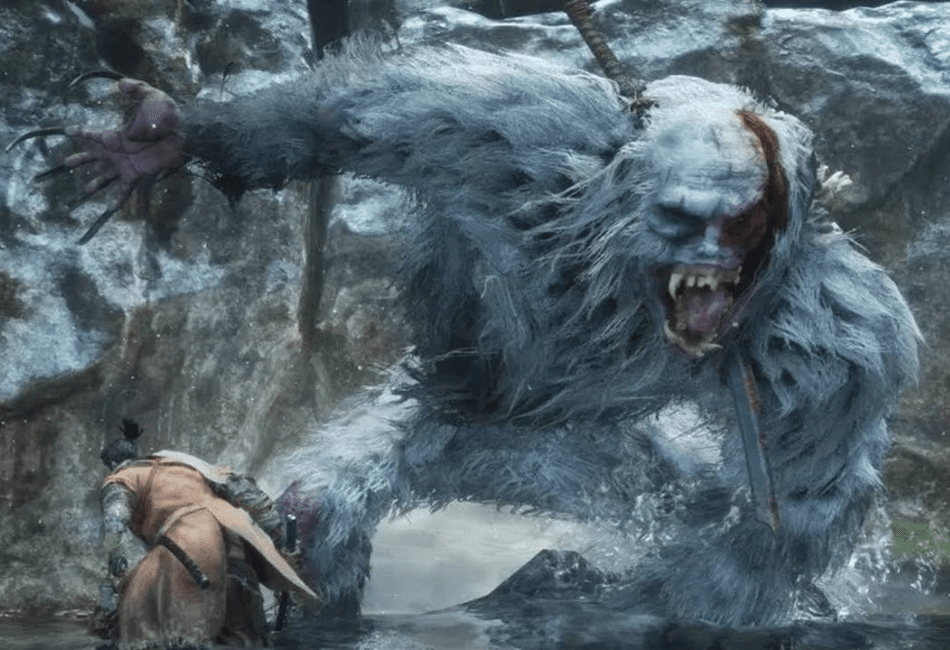Dungeons and Dragons are filled with a menagerie of terrifying and unique monsters for players to come across throughout their adventures.
From krakens lurking in the deep waters to ropers ambushing players from above in the dark cave systems, there is always something just around the corner that can quickly end a character’s life if they aren’t constantly on alert.
This may make facing off against a more mundane D&D monster like the star of this Giant Ape 5e guide seem as though it would be anti-climactic or even dull, but that is far from the truth. If used correctly, this can be a very fun and memorable encounter for your players, and this article has everything you need to know to do just that.
Key Info Up Front
- Book: Monster Manual
- Challenge Rating: 7
- Editions: 5e
- Type: Beast
- Size: Huge
Giant Ape in DnD

While an ape that is bigger than any in the real world is not a very fantastical creature in its own right, it wasn’t introduced to DnD until the fifth edition. Its addition, however, was predated by the introduction of the Dire Ape and various other forms of magical apes.
Dire Apes stood around nine feet tall and p to 1,200 pounds, which is around ordinary times the weight of a normal ape. They only had a Challenge Rating of 3 but were well known to claim forests in warm climates as their territory, which they would ruthlessly defend from any invaders or threats.
The third edition also introduced Girallons. These were white apes with four arms that hunted in the tundra regions of the Forgotten Realms and were known to ambush their prey before beating them to death with a flurry of strikes.
In DnD 4e, there were also Great Apes, but they were much more akin to the folklore and mythology surrounding real-world Great Apes with added aggression for good measure. This saw them being only slightly larger than apes in the real world, leading to them having a place in the world more similar to the apes in The Jungle Book.
Then, with the release of 5e, players finally got introduced to the Giant Ape, a hulking mass of primate extremely territorial and protective of its small group. In many ways, 5e’s Giant Ape is a new interpretation of 3e’s Dire Ape.
The two are roughly the same size, have similar habitats, and share multiple combat behaviors. The main difference between the two is the Giant Ape’s decently raised Challenge Rating of seven compared to the Dire Ape’s three.
Giant Ape Lore
Unfortunately, there is not a lot of specific lore regarding Giant Apes in 5e yet. However, placing them in the Forgotten Realms is easier by drawing from real-world apes and extrapolating that information into the fantasy setting.
While this does put the burden of extra leg work on the shoulders of Dungeon Masters to use this monster, it also gives those DMs a lot more options to explore.
Before looking at the different ways that Giant Apes can be adapted to specific ecologies or locations, however, we should look at the shared characteristics that will always be there. The first is the size of Giant Apes.
Many people may hear the name of the creature and immediately think of King Kong, but 5e’s Giant Apes are much smaller than that and are more akin to the size of an elephant. They stand at nine to ten feet tall and weigh around 1,400 pounds.
Giant Apes in 5e are also highly territorial, which is essential to consider when building an encounter with one. I’ll cover exactly how to use this part of their personality later in this article when I go over how to play a Giant Ape in your D&D campaign.
But, take note now that Giant Apes are so territorial that they are well known to attack any trespassers in their territory regardless of their species or power. A level one adventurer and an ancient dragon invading their home look identical to Giant Apes, who will throw themselves entirely at the intruder.
When it comes to the interaction of Giant Apes with their kind they tend to either live solitary lives or with small groups that can reach up to eight Giant Apes at a time. These groups tend to be patriarchal and are led by a single Giant Ape that is the strongest of the group.
There may be a few other males in the group, but that should only be the case if they are the children of the group’s leader and haven’t grown enough to strike out on their own yet. Most of the group should be females that follow their leader under the promise of protection and the opportunity to breed.
Giant Ape Types

There are no variations of the Giant Ape in the official 5e rules. Still, I think the lack of official lore for the species makes them easy to adapt to various situations and settings so that they can be used in almost any campaign.
This can be done with relative ease by tweaking the Giant Ape’s appearance to match their environment better and some tweaks to their behavior and abilities to make sense as well.
For example, if you want to have a Giant Ape live in the frozen mountains, you should change their fur color to white with an undercoating of grey to allow them to blend in better and ambush their prey.
You could also give them a boost to their Perception checks made to smell to highlight how they would have to smell for prey in the monotonous white surroundings that they live in.
Another fun idea is to have a group of Giant Apes that are obedient to a master or other race. Giant Apes can technically be summoned and commanded with certain spells, which makes the species an excellent option for your players to face while pursuing a sinister circle of druids or other groups dominating the forces of nature in a particular region.
Giant Ape Stats
Giant Apes are all about their Strength and Hardiness. They follow their base impulses in a bestial manner, which limits their intelligence, and their almost complete lack of socialization also limits their Charisma significantly.
To reflect this, their highest stat is Strength, with a respectable level of 23 and a modifier of +6. This is then followed by the strength of their body, and their Constitution level of 18, with a modifier of +4.
Then, their speed is highlighted with a Dexterity of 14, while their ability to find prey is found in their Wisdom score of only 12. Finally, their Intelligence and Charisma are both pretty poor, with levels of only seven, which comes with modifiers of -2.
The limited intelligence of Giant Apes also prevents them from wearing any armor or trying to protect themselves, much beyond just believing that they have the strength to take hits and keep moving, so they have a shallow Armor Class of only 12.
However, this is balanced by an impressive 157 Hit Points. This means that while your players should have an easy time landing hits on a Giant Ape, it will take a considerable number of them to bring the beast down.
The Giant Ape’s stats stand out in its two listed speeds. It has a base movement speed of 40 feet, which can help it navigate the battlefield much faster than most player characters at the level they should be facing.
It also has an impressive climbing speed of 40 feet. This is great because it allows you to make combat encounters with Giant Apes have a lot more verticality, allowing them to be very dynamic and unique to most enemies that players will be used to fighting by this point in the campaign.
It is also higher than most players will be able to match unless they have a magic item like Spider Slippers, are a subclass proficient in climbing, or chose a race capable of flying.
Giant Ape Abilities

Giant Apes are a tad unusual in 5e because most of the exciting components of their stat block are derived from their essential traits and stats, as their combat actions are pretty mundane. However, this does not mean that they are boring to play as a Dungeon Master or to fight as a player but instead emphasizes how they are played.
Play them strictly by their combat actions. You’ll likely find them easily slain by even an underprepared party, and everyone at the table will likely find them not very exciting or interesting.
This is because they only have two combat actions, Fist and Rock, and a Multiattack action that allows them to make two Fist attacks per turn. That Fist attack is made with a +9 attack modifier and a reach of 10 feet.
If it successfully hits the target, it deals bludgeoning damage equal to 3d10 + 6. This is a decently strong attack for a Challenge Rating of only seven, and being able to use each turn can put the hurt on any player characters that get caught by them.
For a range option, Giant Apes have the Rock action. This ranged attack is also made with a +9 to hit and has a minimum range of 50 feet and a maximum of 100 feet. If it successfully hits its one target, it deals a whopping 7d6 + 6 bludgeoning damage.
This maximizes the attack’s damage at 48 hit points, which can down a weaker player character like a Sorcerer or Wizard with a single hit.
Playing a Giant Ape
Roleplaying
It is unlikely that your players will end up having a conversation with a Giant Ape because of their limited intelligence and untamed nature, so most of your effort roleplaying one will happen in combat or leading up to combat as the party observes the monster.
This presents an excellent opportunity to set the scene leading up to a combat encounter and fleshing out the world surrounding the Giant Ape’s domain.
How much you’ll be able to show off the Giant Apes will primarily be determined by how stealthfully your players want to approach their encounter with it. They may end up attacking the Giant Ape on sight, but if they don’t, you can use the opportunity to flesh out the creature’s personality and place in the world.
If you get the chance, I recommend doing this through two scenes, the Giant Ape fighting another creature and them interacting with their small community.
You can show your players the two scenes in either order, but I recommend showing them the Giant Ape fighting another creature first. I recommend doing this first to set the scene for the party’s future combat with it.
Depending on the locale of the Giant Ape, you can give them a different foe to fight first, but I suggest picking one with a bit of flair, like a dinosaur.
This will help your party have information to prepare for the combat as well as create a fantastic scene for them to watch. It could also help to weaken the Giant Ape a bit if you are worried about the party being able to survive an encounter with it.
The second scene of the Giant Ape interacting with its small community is a valuable way to give the party more information about the species if they are into worldbuilding. For this scene, make sure to highlight their community’s patriarchal and power-driven hierarchy.
You can do this by having the Giant Ape interact with some of its mates in a bestial way, like stealing food from them as they pass or training one of their offspring to fight.
This setup can also work well if you want to push your players to empathize with the Giant Apes more by having the Giant Ape act more lovingly toward its community.
However, one of your players may manage to find a way to communicate with a Giant Ape through magical means. If this happens, emphasize the creature’s lower intelligence and general bestial nature. An excellent way to do this is to limit the length of your sentences and have the Giant Ape be quick to anger or jump to conclusions.
This means that your player talking to the Giant Ape may have to make multiple checks to avoid angering it, which will most likely result in it attacking them directly.
Combat

Once your players come to a point where they have to fight a Great Ape, you’ll have to take full advantage of its entire stat block to make the combat encounter as enjoyable as possible.
To do so, you’ll have to utilize the Giant Ape’s speed and verticality as much as possible. You should also have the Giant Ape use its Rock action to initiate combat or ambush the party from a range if it detects them.
Make sure to consider that Giant Apes rely primarily on their sense of smell unless you’ve changed that for their location, which can help them jump on the party by smelling their approach before it can see them.
Then, the Giant Ape can use a well-placed Rock attack or two to initiate combat and start the party off on their back foot. Then, it would help if you played the Giant Ape while taking advantage of its speed as much as possible.
You can do this by having it run between party members, spreading attacks between the entire party. This will give your players numerous attacks of opportunity but be prepared for the Giant Ape to take a lot of extra damage from it.
Once the Giant Ape takes too much damage, you should change its behavior. It wouldn’t make sense for a Giant Ape to run away from a fight if it is in its territory, but it can instead face the players in a more reserved fashion.
It can do this by climbing up trees, walls, or other areas to bring some verticality to the fight and push the players to react accordingly.
While up there, they can still perform ranged attacks, or if you want to mix things up, they can use their brawn to carry a player up the tree with them and then drop them. This creates an ideal situation for players to react to in the middle of the combat encounter.
When your players face the Giant Ape, I also recommend running it with its untamed nature in mind. Giant apes are driven by instincts and even rage so that you can have them furiously attack the party with complete abandon.
You can interpret this in a few ways: having them attack whichever character most recently hit them or dealt the most damage.
Because the Giant Ape’s mental stats are so low, you’ll also likely find that magical players will be able to interrupt the Giant Ape with debuffs and adverse effects throughout the encounter. So, if your Giant Ape lives through a caster’s negative impact, that will likely enrage it enough to focus on trying to kill that caster first.
If your party makes it to the Giant Ape’s community before going into combat, you’ll need to consider how the other Giant Apes react to the players fighting their leader. If your party is at a higher level than the Giant Ape’s challenge rating of seven, I recommend having one or two other Giant Apes step up from within the group to fight the party.
If they aren’t, you can instead have the other Giant Apes be mates for the one the party is fighting. This provides an in-world explanation for why the rest of the Giant Apes wouldn’t attack the party as well since they would instead be hoping that their mate would protect them.
Then, when your party defeats the Great Ape, have all the mates take their young and flee into the surrounding jungle.
You should also adapt the Giant Ape’s approach to combat to suit whatever environment you have them in. If it is a jungle, they should jump from tree to tree, or in the tundra, they can bury themselves in the snow and then jump out to ambush unsuspecting players.
How you ultimately adopt the Giant Ape’s stat block is up to you, so you can tweak it to your preferences to create a dynamic encounter for your party.
If your players face a group of Giant Apes, you’ll have to consider how Giant Apes would approach combat in a group. Since they are very wild by nature, there are two approaches. The first is to have them try to fight very independently to establish their power and not rely on the other Giant Apes that may come for their territory in the future.
The other option is to have them swarm the players and team up on one or two targets at a time. This can make the Giant Apes a hazardous group because of how much damage each Giant Ape can do with two Fist attacks on each turn.
FAQs
Question: Can You Use Polymorph to Turn Into a Giant Ape?
Answer: Yes, you can immediately use polymorph to turn a player character into a Giant Ape when you access the polymorph spell.
Question: How Big is a Giant Ape?
Answer: Giant Apes are classified as Huge, meaning they are nine to ten feet tall and are roughly the size of an elephant.
Question: Can the Giant Ape Attack While Grappling a Creature?
Answer: Since the Giant Ape attacks with a Fist, I think it is reasonable to rule that a Giant Ape could attack another creature while holding one with a grapple. However, I recommend not allowing the Giant Ape to use their Rock attack since they would likely throw the rock with both hands.
Final Thoughts
Giant Apes are not as exciting as most of the monsters in 5e, but they provide an excellent and natural way to flesh out your campaign’s world. Taking full advantage of a Giant Ape encounter will take some effort to make it as enjoyable as possible.
However, they are also easily adapted to any environment or location, allowing you to make them unique for your campaign or throw off experienced players that thought they knew what to expect from Giant Apes in 5e.
- Steel Defender 5e Guide - September 5, 2022
- Harengon 5e Guide - August 24, 2022
- Shambling Mound 5e Guide: The Most Terrifying Plant - August 21, 2022

